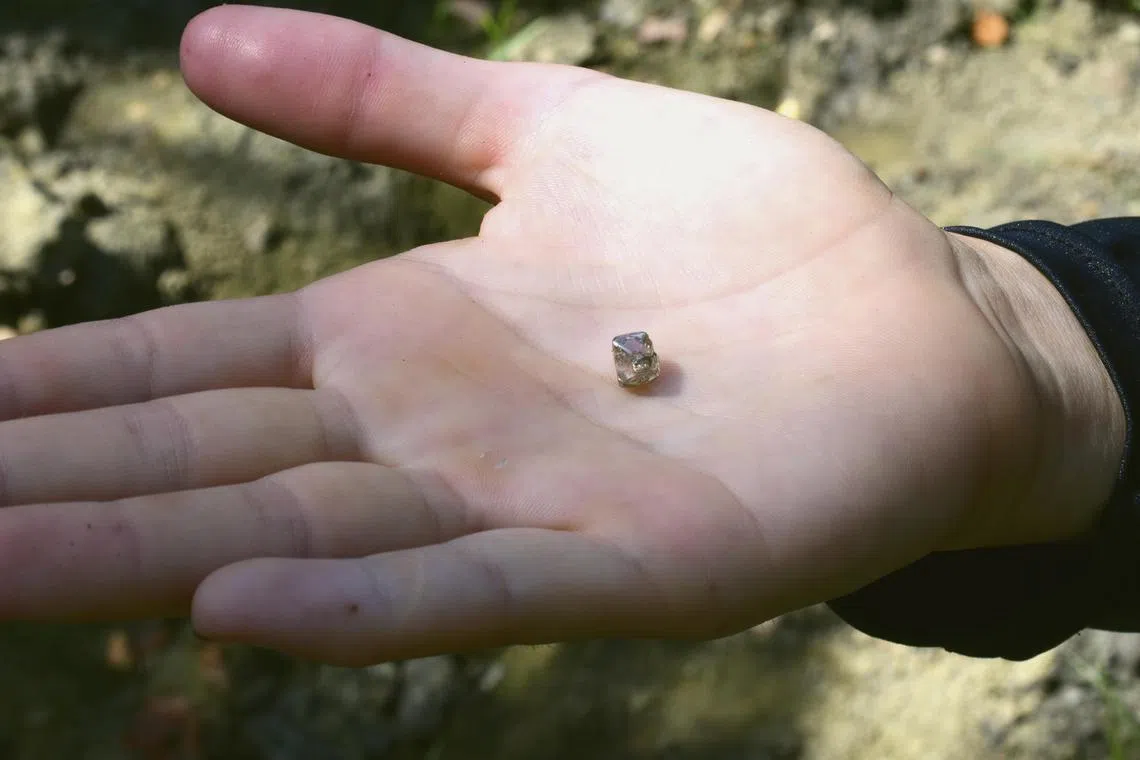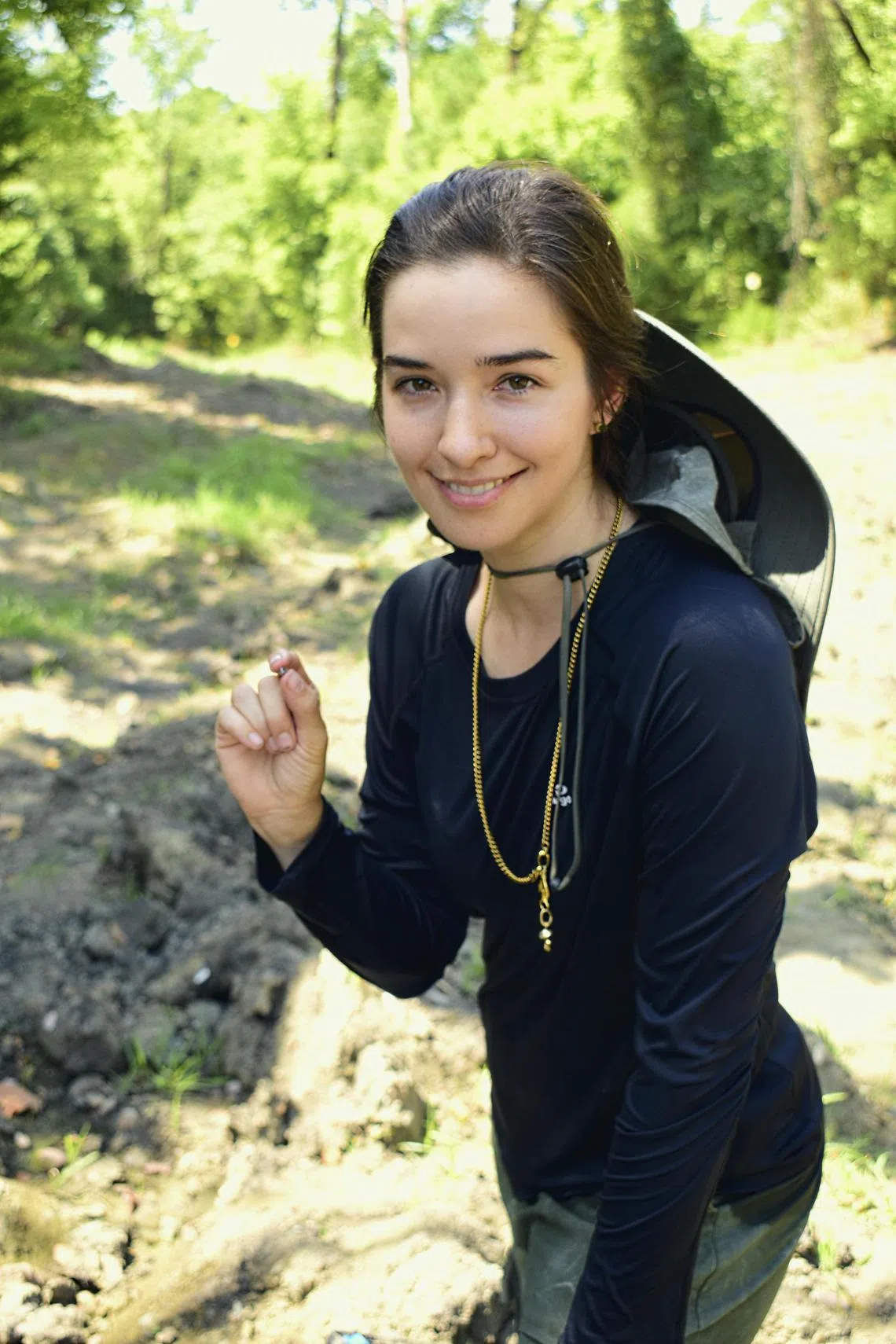With a shovel and a dream, woman finds 2.3-carat diamond in Arkansas
Sign up now: Get ST's newsletters delivered to your inbox

Of 366 diamonds registered so far in 2025, only 11 weighed more than a carat.
PHOTO: ARKANSAS STATE PARKS/NYTIMES
Mark Walker
Follow topic:
NEW YORK – By the end of her trip, Ms Micherre Fox had almost made peace with the fact that she would leave Arkansas with nothing but bug bites and tattered hiking boots.
For three weeks, Ms Fox, who lives in New York City, had been camping at Crater of Diamonds State Park and going out to dig for gems each day.
She rose before dawn, paid the US$15 (S$19) entry fee, walked the half-mile to the fields with her battered tools, and dug, sifted and rinsed until her hands ached. She was on a mission: to find a diamond for her engagement ring.
Wake, walk, work, hope. Repeat.
On her last day there, she slept in and planned to search for an amethyst instead.
“I was coming to terms with the fact I was likely leaving without a diamond,” she said.
But then, as she carried her fourth bucket of dirt to the water pool where diggers rinse their finds, she saw a glimmer in a spider web on the ground, nudging it with her boot. But what looked like glistening dew did not rub off. In fact, it was a shiny stone.
Later that day, after sharing the news with her boyfriend, Ms Fox cried tears of joy: “I’m just like: Oh my God. That was an impossible thing, and I did it and I am proud of that.”
Crater of Diamonds State Park officials later confirmed: Ms Fox, 31, had found a 2.3-carat white diamond, the third-largest find in 2025. Of the 366 diamonds registered so far in 2025, only 11 weighed more than a carat.

Ms Micherre Fox holds a 2.3-carat uncut white diamond she dug up at Arkansas’ Crater of Diamonds State Park.
PHOTO: ARKANSAS STATE PARKS/NYTIMES
Ms Annie Dye, a gemologist based in New York state, said that depending on the final cut, clarity, colour and carat weight, the diamond could be worth anywhere from US$10,000 to US$50,000. The couple have yet to get it appraised, so its precise value remains unknown.
Each year, about 160,000 people, on average, come to Crater of Diamonds State Park, about a 180km drive south-west from Little Rock, in hopes of digging up a diamond they can keep.
Most days, diggers take their finds to the park’s experts to learn what they found. The park has a “finders, keepers” policy, making anything they dig up theirs to take home at no added cost. But often, it’s one of three less-valuable rocks: smooth brown jasper; angular quartz; or soft and brittle calcite.
Every so often, someone makes a historic find. Like Mr Bobbie Oskarson of Longmont, Colorado, who found a white, 8.52-carat diamond in June 2015.
Ms Fox, who had just graduated with a master’s degree in management from Fordham University in New York, had come for adventure and to find a jewellery piece she could dig from the ground herself.
When she and her partner began to talk about marriage two years ago, she quickly realised she wanted to find a diamond rather than buy one. In addition to avoiding the exploitative diamond mining industry, this stone would represent the kind of work marriage would require, she felt, and show her commitment.
“There are countless things that will happen that you can’t just solve with money,” she said, “and in those moments, you need to be able to roll your sleeves up and show up every day and do really hard work to keep that thing going.”
For her, “this was an opportunity for me to symbolically commit to doing that work,” she added.
There were setbacks. About a week in, she got bitten up by chiggers, which left her itching for weeks. Almost a week later, her hand shovel was stolen, forcing her to dig with her bare hands until her nails were worn down.
Two days after that, the soles of her brown boots flapped, like old paint peeling from a wall, with each step.
“Socks were probably peeking out like two days after that,” Ms Fox said.
Still, the field called.
By mid-morning of the final day, after more than 12km of walking to a nearby town to treat herself to an iced latte, she reached the 15ha of plowed brown fields.
It was then that she came across what looked like a spider web beaded with dew in the dirt.
With a hint of reluctance, she bent down, still carrying a heavy bucket, and picked up what she thought would turn out to be a mica stone. Small as a canine tooth, it caught the light differently. Oily, metallic.
“I kept telling myself, ‘It’s just glass with silver paint,’” she said.
She clinched the stone in her fist, dirt still clinging to her hands. Around her, the field hummed with the quiet industry of strangers who did not yet know that a diamond had just left the ground. She began the walk to the gemologist’s office.
A three-minute stroll, she recalled, that felt closer to 30. She kept her pace slow. Trying to stay level and not get her hopes up.
At the gemologist’s desk, where most hopefuls learn in seconds they do not have a diamond, she placed the stone on the counter. Instead of a quick no, there was movement – staff members summoned, the stone carried to a back room. Eventually, they called her in: It was a white diamond, more than 2 carats.
Ms Fox asked for a moment alone to share the experience with her boyfriend, Mr Trevor Ballou, 37, before continuing to answer more questions from the state park’s staff about the diamond.
In a quiet room, the relief and exhaustion hit her at once, she said. After days of heat, hard soil and the constant weight of possible failure, she let the moment wash over her. The ache in her muscles, the grit in her hands and the improbable reward glinting in the light.
She fell to a knee, her fist pressed into the ground, tears running down her face.
“I crumbled,” Ms Fox said. “My head was bent to the ground and my eyes were wet, and I’m just like: Oh my God. That was an impossible thing, and I did it and I am proud of that.”
Later, carrying the diamond in a small box nestled in a fanny pack strapped across her chest, she flew home from Arkansas with a sense of triumph the next day.
Back in New York, at their apartment in Manhattan’s West Village, her boyfriend was waiting with her favourite french fries from Bubby’s, a popular home-style American eatery.
“I hunted this for you,” she said, and then presented him with a box containing the diamond.
Now the ball is in Mr Ballou’s court. When is he going to propose, and what’s his plan?
In an interview, he said: “I’ll say this, I certainly have to find a way to live up to this now. She’s dealt her cards and now it’s my turn to put together something impressive, and I’m really looking forward to that.”
Any diamond over 2 carats found at the Crater of Diamonds State Park gets a name.
This one is named the Fox-Ballou Diamond, after the couple’s last names.
Now, it just needs a ring. NYTIMES

